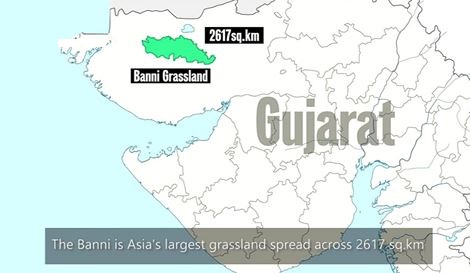Note4Students
From UPSC perspective, the following things are important :
Prelims level: Project Cheetah, Banni Grasslands, Gandhi Sagar WLS
Why in the News?
- The Gandhi Sagar sanctuary in Madhya Pradesh is the preferred location for the next batch of cheetah’s relocation plan.
- However, Banni in the Rann of Kutch, Gujarat is also being prepared to house some of them.
Cheetah Reintroduction in India:
|
About Gandhi Sagar Wildlife Sanctuary
- It is located in western Madhya Pradesh and covers an area of 368.62 sq km.
- It is a flat rocky plateau characterized by shallow topsoil and exposed sheetrock.
- It is divided by the Chambal River, with the Gandhi Sagar dam and reservoir within its boundaries.
- Flora and Fauna:
- Flora: The sanctuary features a savannah ecosystem with open grasslands interspersed with dry deciduous trees. Riverine valleys within the sanctuary support evergreen vegetation.
- Fauna: The sanctuary is home to a diverse range of wildlife, including species like leopards, sloth bears, striped hyenas, grey wolves, golden jackals, jungle cats, Indian foxes, and marsh crocodiles.
About Banni Grasslands:
- The Banni Grassland is located in the Kutch district of Gujarat, covering around 3,847 square km.
- The climate is arid and semi-arid, with extremely hot summers (temperatures above 45°C) and mild winters (12°C to 25°C), receiving 300-400 mm of annual rainfall mainly during the monsoon.
-
- Flora: Grasses such as Dichanthium, Sporobolus, and Cenchrus species, with salt-tolerant plants, shrubs, and trees like Acacia and the invasive Prosopis juliflora.
- Fauna: Indian wolf, hyena, chinkara, Great Indian Bustard, flamingos, and various raptors, reptiles, and invertebrates.
- It is inhabited by pastoral communities like the Maldharis, who rely on livestock grazing (cattle, buffalo, and sheep) for their livelihood.
- Agriculture is limited due to arid conditions, with some areas used for salt production.
PYQ:[2024] Consider the following statements: 1. Lions do not have a particular breeding season. 2. Unlike most other big cats, cheetahs do not roar. 3. Unlike male lions, male leopards do not proclaim their territory by scent marking. Which of the statements given above are correct? (a) 1 and 2 only (b) 2 and 3 only (c) 1 and 3 only (d) 1, 2 and 3 [2012] Consider the following: (2012)
Which of the above are naturally found in India? (a) 1, 2 and 3 only |
Get an IAS/IPS ranker as your 1: 1 personal mentor for UPSC 2024

